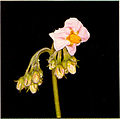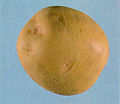| This article includes a list of references, related reading, or external links, but its sources remain unclear because it lacks inline citations. Please help improve this article by introducing more precise citations. (March 2013) (Learn how and when to remove this message) |
| 'Yukon Gold' | |
|---|---|
 The golden yellow flesh of the 'Yukon Gold' potato The golden yellow flesh of the 'Yukon Gold' potato | |
| Genus | Solanum |
| Species | Solanum tuberosum |
| Hybrid parentage | 'Norgleam' × W5279-4 |
| Cultivar | 'Yukon Gold' |
| Origin | Ontario, Canada |
'Yukon Gold' is a large cultivar of potato most distinctly characterized by its thin, smooth, eye-free skin and yellow-tinged flesh. This potato was developed in the 1960s by Garnet ("Gary") Johnston in Guelph, Ontario, Canada, with the help of Geoff Rowberry at the University of Guelph. The official cross bred strain was made in 1966 and 'Yukon Gold' was finally released into the market in 1980.
Development and naming

In the 1900s, many Dutch and Belgian immigrants began settling in the "Banana Belt" region of southern Ontario. Many of these immigrants began vegetable farming around the towns of Simcoe, Leamington, and Harrow along the shore of Lake Erie. In the 1950s, the vegetable growers of this region began petitioning for the breeding rights and licensing for a yellow-fleshed potato like ones they were used to growing in Europe. For Gary Johnston, this began the nearly 30-year development of the 'Yukon Gold' potato.
In 1953, Johnston was a lab technician in the potato development laboratory at the Ontario Agriculture College and he led a team that cross-bred two varieties to create the new type. In 1959, one of Johnston’s graduate students, a young man originally from Peru, told him of a small, rough, deep-yellow-fleshed potato (Solanum goniocalyx, known as papa amarilla, Spanish for "yellow potato") that was grown by the many indigenous communities in the Peruvian Andes. In Lima, this cultivar is considered a delicacy for its bright colour and distinct flavour. After trying these Peruvian potatoes, Johnston set out to breed a potato with the same colour and flavor characteristics, but larger in size and with a smoother shape, similar to the potatoes being grown in that part of Southwestern Ontario. In 1966, the development team made their first cross between a W5289-4 (2× cross between 'Yema de huevo' and 2× Katahdin) and a 'Norgleam' potato native to North Dakota. After the 66th cross that year, a true-breeding seed was produced, and the G6666 was created.
The early name for the new cultivar was "Yukon", for the Yukon River involved in the Klondike Gold Rush in Northern Canada. Charlie Bishop, or Walter Shy according to some sources, suggested adding "Gold" to describe the colour and appearance. "It was a revolutionary concept ... He was a pioneer. He had the vision for yellow-fleshed potatoes", said Hielke De Jong, a potato breeder with Agriculture and Agri-Food Canada. Johnston also developed and brought 15 other potato varieties to market while at the Ontario Agriculture College lab, where he had been seconded by his employer, Agriculture Canada.
A University publication states that "Yukon Gold was the first Canadian-bred potato variety to be promoted, packaged and marketed with its name right on the pack".
In spite of the overwhelming success of this potato for some years, sales in Canada dropped 30% between 2004 and 2014 as other varieties became increasingly popular.
Yukon Gold potatoes are susceptible to seed decay, blackleg, early blight, late blight, early dying, PVY, soft rot, dry rot, leak, pink rot, silver scurf, and black scurf.
Storage
This cultivar is resistant to bruising and does not sprout a lot because it has good dormancy. If tubers are stored correctly they will not lose a lot of moisture compared to other cultivars. It is important that the lenticels are not swollen and that the skin is not bruised because this can lead to major rot issues.
See also
References
- Colin Butler (5 April 2019). "Guelph invented the jockstrap and 9 other facts as Storm take on London Knights". CBC News. Retrieved 7 April 2019.
- ^ "Yukon Gold Potato Celebrates 50th Anniversary". University of Guelph. 16 May 2016. Retrieved 7 April 2019.
Gary Johnston bred Yukon Gold at the University of Guelph in 1966, elevating the potato to '"something special"
- "Yukon Gold: Characteristics". Institute of Agriculture and Natural Resources: Cropwatch. University of Nebraska. 1 May 2012. Retrieved 7 April 2019.
Yukon Gold was crossed and developed at the University of Guelph, Ontario, Canada in the 1960s and 70s, and released in 1980 by Agriculture Canada at the University of Guelph (Johnston and Rowberry. 1981. Amer Potato Jour 58:241-244). As a yellow-fleshed cultivar, it was considered a specialty or gourmet variety and didn't gain popularity until the past few years. Last year, over 160 acres of Yukon Gold were grown for seed in Nebraska and over 1800 seed acres nationwide. It has become a popular supermarket sale commanding a premium price from shoppers.
- "In praise of the Yukon Gold potato". Macleans. 23 April 2016. Retrieved 7 April 2019.
Johnston died in 2000, at age 85, of diabetes complications, having never made a penny off his potato (prior to the 1990 Canadian Plant Breeders' Rights Act, breeders didn't have intellectual property rights).
- Irvis Osbert Medina. "Papa Amarilla" (in Spanish). Mi Cocina Peruana ("My Peruvian Cuisine"). Retrieved 4 March 2017.
- "In praise of the Yukon Gold potato". Macleans. 23 April 2016. Retrieved 7 April 2019.
The invention came from a male parent grown in North Dakota (considered male because it spreads pollen), and a female, yellow parent grown in Peru. After 14 years, on the 66th cross of 1966, Johnston created a variety known technically as G6666-4y ("G" for Guelph, 4 for the fourth selection from the cross, and "y" for yellow) ... his colleague Walter Shy suggested adding the word "Gold"
- "Canadian-bred Yukon Gold potato, beloved by cooks, marks 50th anniversary". National Post. 9 May 2016. Retrieved 7 April 2019.
Altogether Johnston developed and brought 16 potato varieties to market. At one time, the top four varieties of potato were his, says the University of Guelph, where he was based with Agriculture Canada for close to 30 years.
- "Garnet Richard Johnston". University of Guelph. September 18, 2014. Retrieved 7 April 2019.
First name: Garnet Richard Last Name: Johnston, From 1953 to 1980, he was a research scientist with the Canada Department of Agriculture seconded to OAC.
- "In praise of the Yukon Gold potato". Macleans. 23 April 2016. Retrieved 7 April 2019.
Docherty, who stopped growing Yukon Golds about five years ago, says, "every breeder in the world is trying to find a replacement for the Yukon Gold."
- ^ Network, University of Nebraska-Lincoln | Web Developer (17 September 2015). "YUKON GOLD: MANAGEMENT PROFILE | CropWatch". cropwatch.unl.edu. Retrieved 2016-12-02.
External links
- Yukon Gold Characteristics
- Yukon Gold Information Page
- Yukon Gold Potato Research Program History Archived 2012-02-20 at the Wayback Machine
- Canadian Food Inspection Agency: Yukon Gold
- #826a21 Hex Color - Yukon Gold - Color Hex Map






